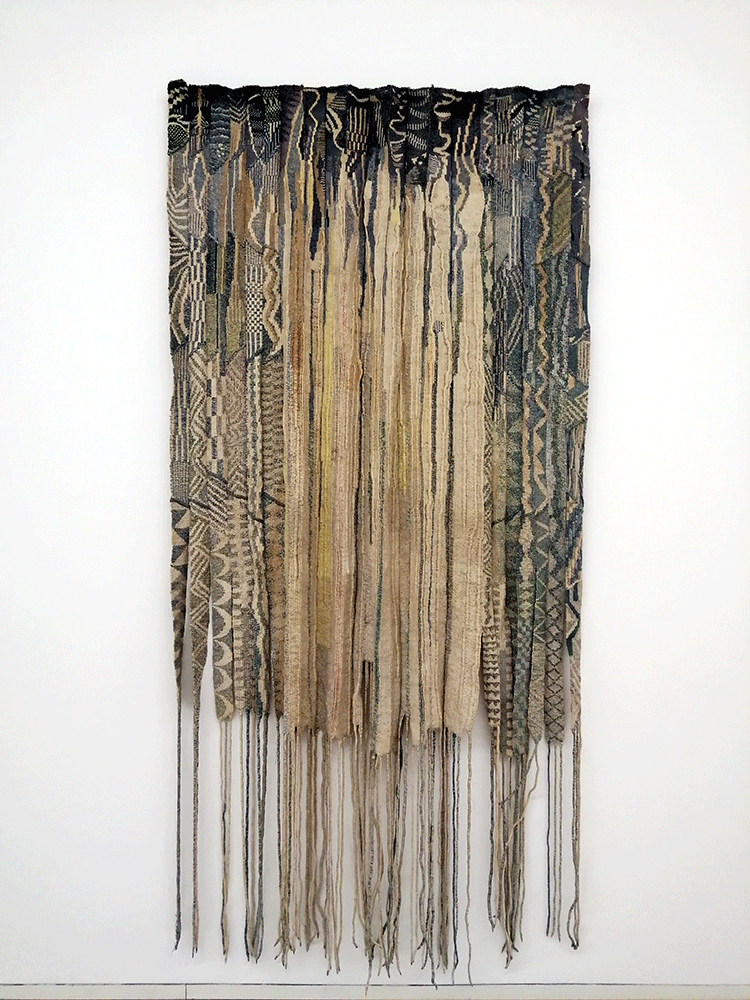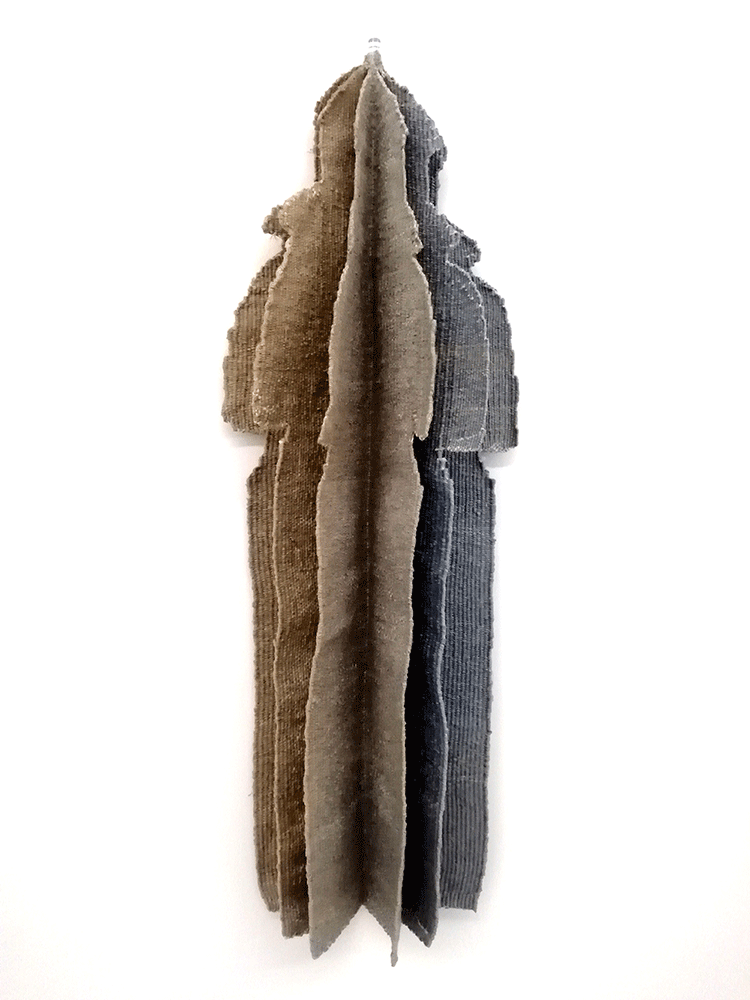

PT
Gisella Santi nasceu em Pescopagano (Itália) a 12 de maio de 1922.
Em 1944, formou-se em Pintura Mural na Escola Santa Maria del Carmine em Veneza. Mais tarde, em Milão, frequentou o Curso de Desenho de Modelo na Academia de Brera e um atelier escola de restauro de obras de arte, onde aprendeu técnicas de restauro de pintura e de tapeçaria.
A sua ligação com a arte têxtil iniciou-se em Lisboa quando dirigiu, de 1957 a 1974, uma oficina de restauro de têxteis antigos – tapeçarias, tapetes e tecidos bordados -, onde chegou a coordenar cerca de trinta colaboradoras. Como mulher empresária independente, desenvolveu uma atividade notável na área do restauro e o seu trabalho foi reconhecido por museus, antiquários e particulares.
Com a Revolução de Abril, o restauro entrou em crise e Gisella Santi redirecionou a sua atividade para um trabalho mais autoral no âmbito da produção artística têxtil. Curiosa e entusiasta com as correntes da arte têxtil da época, divulgadas principalmente pelas Bienais de Lausanne, lançou-se no seu percurso de artista têxtil.
Nesta altura, dedicou-se também ao ensino. Foi solicitada para dar formação e abre o seu atelier onde organizou estágios para professores e artistas, divulgando as técnicas tradicionais e contemporâneas da tapeçaria. Interveio ativamente como formadora e monitora de diversos cursos e lecionou como professora de tecnologia de tapeçaria do Curso de Artes dos Tecidos da Escola Artística António Arroio.
Por um lado, pelo seu passado do restauro, encontrou-se ligada a técnicas têxteis mais tradicionais, por outro, fascinada pela capacidade de organizar as fibras e fios numa dimensão mais escultórica, explorou as possibilidades das estruturas têxteis, da textura e expressividade dos materiais, da cor e da forma numa incessante pesquisa e experimentação ao encontro de novos desafios.
Não menos relevante do que o trabalho individual da artista, há que salientar a importância que esta teve na criação de coletivos que promoveram a arte têxtil através de bienais, simpósios e exposições que potenciaram a sua divulgação tanto no âmbito nacional como internacional. A Cooperativa ARA, que fundou com Flávia Monsaraz em 1975, foi apenas o início. Depois o Grupo 345 – Associação de Tapeçaria Contemporânea Portuguesa – fundado em 1978 – que consagrou muitos dos artistas têxteis que frequentavam o seu atelier-escola. Também a sua participação na 1ª Bienal de Tapeçaria de Matosinhos e coorganização do I e II Simpósio de Tapeçaria de Loures.
Em 2003 foi condecorada pela República Italiana com o título de Comendador da Ordem da Estrela de Itália, pelo trabalho de artista e dinamizadora cultural no âmbito da arte têxtil.
A artista faleceu no dia 13 de junho de 2006, em Lisboa.
Sobre as obras apresentadas na exposição:
transcreve-se parte da conversa1 entre Madalena Braz Teixeira – então diretora do Museu Nacional do Traje – e Gisella Santi.
M.B.T. – Gisella, a tapeçaria é uma coisa mental?
G.S. – Inegavelmente. Antes de executar, concebo estética e tecnicamente. Componho a estrutura e vou imaginando os efeitos decorativos. O material também comanda um bocado, sobretudo no caso da tapeçaria experimental pois são os nós, os cruzamentos e os enlaces de fios que constroem e organizam esta expressão artística. As vezes faço uma maqueta que pode ser até de papel. Claro, a conceção está na cabeça, mas é muito, muito manual. A mão conduz-me na escolha e enquanto estou elaborando, vou pensando noutras formas e vem-me à cabeça inúmeras alternativas.
M.B.T. – O resultado agrada-lhe sempre?
G.S. – Já me aconteceu ter a necessidade de fazer uma tapeçaria complementar à primeira como no caso de Origens, que acabaram por ser Origens I e Origens II. Há tantas, tantas outras peças que nunca se vêm a fazer. Sinto-me sempre em desafio. São trabalhos longos, lentos e muito demorados e por isto é que há muitas e muitas tapeçarias que nunca se fazem.
A par dos desafios na materialização dos seus trabalhos, Gisella era sensível ao mundo que a rodeava, expressando muitas vezes nas suas obras questões que se lhe apresentavam perturbadoras do ponto de vista político, social, económico e ecológico, com a firme convicção que comunicar através do objeto artístico era uma forma de intervenção para mudar o mundo.
A obra “Uns e Outros” de 1991 (técnica mista, lã fiada à mão; sisal; rede; desperdício de algodão; papel; linho; rede metálica e serapilheira de juta) procura “(…) explicar e representar a ideia de diversidade, diferença na igualdade, convivência tolerante, espírito de grupo e solidariedade. (…) a vida natural tanto cósmica como terrena.” O orgânico e o inorgânico.
A utilização de diversas estruturas, linho e seda, na peça “Cascata” de 1993 faz a “(…) exaltação da água como elemento purificador. A (…) Cascata com um caráter mais reservado e até intimista, conotada que parece estar à dimensão de um jardim romântico ou até mais precisamente de um (jardim) interior.”
A peça “Ídolos de Alá” de 1994 (técnica de Gobelins, lã ) remete para a cultura árabe que nos é historicamente tão próxima, mas também para a tolerância e intolerância religiosa.
1 Catálogo da exposição da artista Gisella Santi no Museu Nacional do Traje, sobre o tema Henrique o Navegador, Lisboa 1994.
ENG
Gisella Santi was born in Pescopagano (Italy) on 12th May 1922. In 1944, she graduated in Mural Painting at the Santa Maria del Carmine School in Venice. Later, in Milan, she attended the Model Design Course at the Brera Academy and an atelier school for the restoration of works of art, where she learned painting and tapestry restoration techniques.
Her connection with the textile arts began in Lisbon when, from 1957 to 1974, she ran a workshop for the restoration of antique textiles – tapestries, carpets and embroidered fabrics – where she coordinated around thirthy collaborators. As an independent woman entrepreneur, she developed a remarkable activity in the area of restoration and her work was recognised by museums, antique dealers and private individuals.
With the April Revolution, restoration entered into crisis and Gisella Santi redirected her activity towards a more authorial work in the field of artistic textile production. Curious and enthusiastic about the currents in textile art of the time, disseminated mainly by the Lausanne Biennales, she embarked on her path as a textile artist.
At this time, she also dedicated herself to teaching. She was asked to give training and opened her atelier where she organized training courses for teachers and artists, promoting traditional and contemporary tapestry techniques. She actively intervened as a trainer and monitor of various courses and taught tapestry technology in the Arts of Textiles Course of António Arroio Art School.
On one hand, due to her background in restoration, she found herself linked to more traditional textile techniques and on the other hand, fascinated by the ability to organise fibres and threads in a more sculptural dimension. She explored the possibilities of textile structures, the texture and expressiveness of materials, colour and form in a ceaseless search and experimentation to find new challenges. No less relevant than the artist’s individual work is the importance she had in the creation of collectives that promoted textile art through biennials, symposiums and exhibitions that boosted its dissemination both nationally and internationally. The ARA Cooperative that she founded with Flávia Monsaraz in 1975 was only the beginning. Then there was Group 345 – Portuguese Contemporary Tapestry Association – founded in 1978 – which consecrated many of the textile artists that attended her atelier-school. Also her participation in the 1st Matosinhos Tapestry Biennial and co-organization of the 1st and 2nd Loures Tapestry Symposium.
In 2003 she was distinguished by the Italian Republic with the title of Commander of the Order of the Star of Italy for her work as an artist and cultural promoter in the field of textile art.
The artist died on June 13th 2006, in Lisbon.
About the works presented in the exhibition:
transcription form part of a conversation1 between Madalena Braz Teixeira – then director of the Museu Nacional do Traje – and Gisella Santi.
M.B.T. – Gisella, is tapestry a mental thing?
G.S. – Undeniably. Before executing, I conceive aesthetically and technically. I compose the structure and imagine the decorative effects. The material is also a determining factor, especially in the case of experimental tapestry because it is the knots, the crossings and the links between threads that construct and organise this artistic expression. Sometimes I make a model that can even be made of paper. Of course the conception is in my head but it is very, very manual. The hand leads me in the coice and while I am elaborating, I am thinking of other forms and countless alternatives come to mind.
M.B.T. – Do you always like the result?
G.S. – I have already had the need to make a tapestry to complement the first one as in the case of “Origens” which ended up being “Origens I” and “Origens II”. There are so many, many other pieces that never come to be made. I always feel challenged. They are so long, slow and very time consuming works and that is why there are so many tapestries that are never made.
Alongside the challenges in materialising her works, Gisella was sensitive to the world around her, often expressing in her works disturbing issues from a political, social, economic and ecological point of view with the firm conviction that communicating through the artistic object was a form of intervention to change the world.
The work “Uns e Outros” from 1991 (mixed technique, hand-spun wool; sisal; net; cotton waste; paper; linen; metallic net and jute burlap) seeks to “(…) explain and represent the idea of diversity, difference in equality, tolerant coexistence, group spirit and solidarity. (…) natural life both cosmic and earthly.” The organic and the inorganic.
The use of different structures, linen and silk, in the piece “Cascata” from 1993 makes the “(…) exaltation of water as a purifying element. The (…) Waterfall with a more reserved and even intimate character, connoted that seems to be the size of a romantic garden or even more precisely an interior (garden).
The piece “Idolos de Alá” from 1994 (Gobelins technique, wool) refers to the Arab culture that is historically so close to us, but also to religious tolerance and intolerance.
1 Catalog of the exhibition by the artist Gisella Santi at the Museu Nacional do Traje, on the theme Henrique o Navegador, Lisbon 1994.
